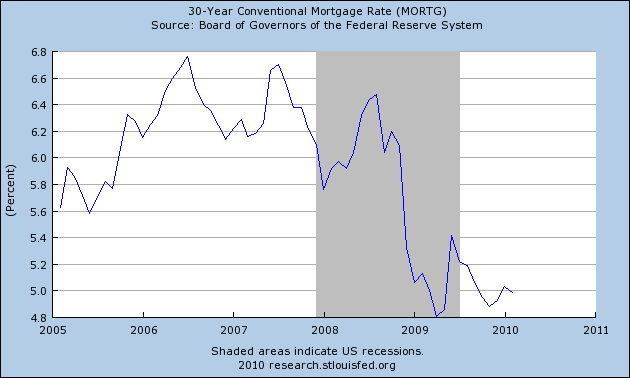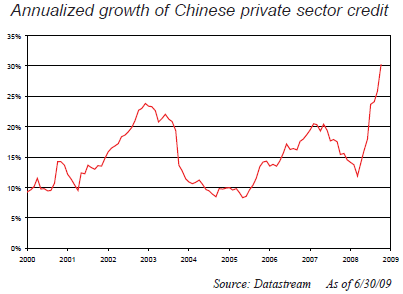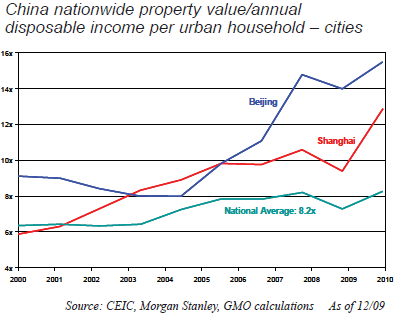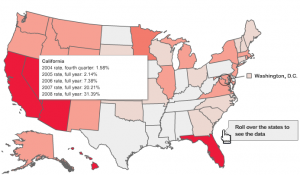Home » Posts tagged 'Housing' (Page 3)
Tag Archives: Housing
Jim Grant critiques Greenspan
Jim Grant has some tough words on Alan Greenspan, and central bankers in general.
How to watch China bubble
Ed. Chancellor of GMO (in Boston) has put out an excellent piece on the Chinese market and the “red flags” for investors.
The paper addresses how to identify the proper “speculative manias” and associated financial crises in the country. Chancellor sums it into key points, breaking down the bare essentials:
1. Great investment debacles generally start out with a compelling growth story.
2. A blind faith in the competence of the authorities is another typical feature of a classic mania. In other words, you can’t always trust the numbers that a government is putting out.
3. A general increase in investment is another leading indicator of financial distress. Capital is generally misspent during periods of euphoria.
4. Great booms are invariably accompanied by a surge in corruption. Countrywide, anyone?
5. Strong growth in the money supply is another robust leading indicator of financial fragility. Easy money lies behind all great episodes of speculation from the Tulip Mania of the 1630s – which was funded with IOUs – onward.
6. Fixed currency regimes often produce inappropriately low interest rates, which are liable to feed booms and end in busts.
7. Crises generally follow a period of rampant credit growth. In the boom, liabilities are contracted that cannot subsequently be repaid. The U.S. will ultimately be a perfect example of this.
8. Moral hazard is another common feature of great speculative manias. Greed isn’t necessarily good and we tend to act irresponsible during intense periods of speculation.
9. A rising stock of debt is not the only cause for concern. Investments financed with borrowed money don’t generate enough income to either service or repay the loan (what Minsky called “Ponzi finance”).
10. Dodgy loans are generally secured against collateral, most commonly real estate. Thus, a combination of strong credit growth and rapidly rising property prices are a reliable leading indicator of very painful busts.
American Dream 2: Default, then Rent
The housing market is back down, in both sales of new homes and existing homes. The crawling recovery in both housing market and labor market put a deep dent on American consumers’ wealth and income. The danger still exists that the U.S. will follow Japan into a lost decade.
(click to enlarge; graph courtesy of CalculatedRisk)
American Dream of owning a house will soon turn to (arguably, has already turned) Dream v2: “default, then rent”:
People’s increasing willingness to abandon their own piece of America illustrates a paradoxical change wrought by the housing bust: Even as it tarnishes the near-sacred image of home ownership, it might be clearing the way for an economic recovery.
Thanks to a rare confluence of factors — mortgages that far exceed home values and bargain-basement rents — a growing number of families are concluding that the new American dream home is a rental.
Some are leaving behind their homes and mortgages right away, while others are simply halting payments until the bank kicks them out. That’s freeing up cash to use in other ways.
The U.S home-ownership rate has charted its biggest decline in more than two decades, falling to 67.6% as of September from a peak of 69.2% in 2004. And more renters are on the way: Credit firm Experian and consulting firm Oliver Wyman forecast that “strategic defaults” by homeowners who can afford to pay are likely to exceed one million in 2009, more than four times 2007’s level.
Stiffing the bank is bad for peoples’ credit, and bad for banks. Swelling defaults could also mean more losses for taxpayers through bank bailouts.
Analysts at Deutsche Bank Securities expect 21 million U.S. households to end up owing more on their mortgages than their homes are worth by the end of 2010. If one in five of those households defaults, the losses to banks and investors could exceed $400 billion. As a proportion of the economy, that’s roughly equivalent to the losses suffered in the savings-and-loan debacle of the late 1980s and early 1990s.
(click to play the interactive graph of Strategic Default)
The flip side of those losses, though, is massive debt relief that can help offset the pain of rising unemployment and put cash in consumers’ pockets.
For the 4.8 million U.S. households that data provider LPS Applied Analytics estimates haven’t paid their mortgages in at least three months, the added cash flow could amount to about $5 billion a month — an injection that in the long term could be worth more than the tax breaks in the Obama administration’s economic-stimulus package.
“It’s a stealth stimulus,” says Christopher Thornberg of Beacon Economics, a consulting firm specializing in real estate and the California economy. “The quicker these people shed their debts, the faster the economy is going to heal and move forward again.”
As the stigma of abandoning a mortgage wanes, the Obama administration could face an uphill battle in its effort to keep people in their homes by pressuring banks to cut their mortgage payments. Some analysts argue that’s not always the right approach, particularly if it prevents people from shedding onerous debts and starting afresh.
“The effect of these programs is often to lead homeowners to make decisions that are not in their economic best interests,” says Brent White, a law professor at the University of Arizona who has studied mortgage defaults.









![Reblog this post [with Zemanta]](https://img.zemanta.com/reblog_e.png?x-id=8e58cb77-e39e-49a8-b96a-90e6b9c63b56)